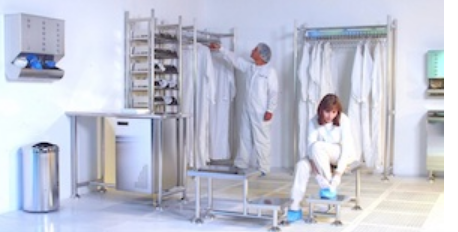Our Cleanroom Furnishings are:
- Available in 304 or 316 Stainless Steel or PVC plastic
- Non-particulating
- Non-accumulating
- Non-flammable
- Constructed for life-long durability
- Ergonomically designed
- Designed for heavy duty use
- Easily installed and maintenance-free
Stainless steel furnishings has emerged as a preferred choice for cleanroom applications due to its exceptional properties that align with the requirements of these environments:
- Corrosion Resistance: Stainless Steel is highly resistant to corrosion, rust, and staining. This property ensures that the furniture maintains its integrity even in the presence of harsh chemicals and cleaning agents commonly used in cleanrooms. It also prevents the shedding of particles that can contaminate the environment.
- Hygiene: Cleanrooms demand the highest standards of cleanliness. Stainless Steel is non-porous and easy to clean, making it an excellent choice for maintaining a sterile environment. Its smooth surface minimizes the chances of bacterial growth, ensuring that cleanroom furniture remains free from contaminants.
- Durability: Stainless Steel is incredibly durable and can withstand heavy use, impact, and wear over time. This durability reduces the need for frequent replacement, resulting in long-term cost savings.
- Chemical Resistance: Cleanrooms often use various chemicals and disinfectants for cleaning and sanitizing purposes. Stainless Steel is resistant to many chemicals, ensuring that the furniture remains unaffected and does not compromise the cleanliness of the environment.
- Strength and Load-Bearing Capacity: Stainless steel is known for its strength, making it suitable for supporting heavy equipment and materials commonly found in cleanrooms. This strength also ensures the furniture maintains its structural integrity over time.
Most of the Furnishings we offer are available using 304 or 316L Stainless Steel. For more information on the pros and cons of 304 versus 316L Stainless Steel, click here to download the Application Note #3.
Stainless Steel finishes are available with mechanical polishing or electropolishing.
Advantages of electropolishing over mechanical polishing include:
- Improved corrosion resistance
- Improved surface smoothness
- Improved surface reflectivity, brightness and appearance
- Hygienically clean surface (resistance to bacteria growth)
- Easier cleaning
- Fewer particles on surface – electropolishing is not a surface coating, and therefore poses no risk of surface distortion or peeling over time
- Easier polishing and passivating of areas that are inaccessible to mechanical polishing
Some terminology that helps you decide the best design for your application:
- Flat edge – the top surface meets each vertical surface in a 90° edge
- Rolled edge – the top surface meets the front/back edges with a rolled or rounded edge. Typical use is a gowning bench so no sharp edges against the body
- Bull nose edge – all four edges are rolled or rounded
- Marine edge – the edges of the top surface are raised to create a wide barrier around the perimeter. Used on counter tops, carts and desks to prevent any spills from rolling over the top surface
- Lip up flange – similar to Marine edge except the barrier is typically the thickness of the metal. Used to contain any spills
- Perforated top – the top surface can be perforated if the application requires increased airflow and there is no risk of spillage
- Sealed undersides – the underside of the top surface is completely sealed to prevent any openings where contaminates can collect
- Fully welded – used in cGMP applications that require no gaps, seams or hardware holes where contaminates can collect. The product is fully assembled and welded before shipping. No assembly is required but shipping is typically more expensive as the product more space in shipping
- Unassembled/Flat packed – the product required some assembly on-site. Shipping costs are lower
 Sentinel Process Systems/SPS CleanTech offers unique furnishings solutions that are durable, intended for heavy use, can stand up to a rigorous cleaning schedule and have a long life. Users should realize long-term cost savings through reduced maintenance and replacement costs. Standard designs as well as custom-built designs for unique applications are available with competitive lead times.
Sentinel Process Systems/SPS CleanTech offers unique furnishings solutions that are durable, intended for heavy use, can stand up to a rigorous cleaning schedule and have a long life. Users should realize long-term cost savings through reduced maintenance and replacement costs. Standard designs as well as custom-built designs for unique applications are available with competitive lead times.















